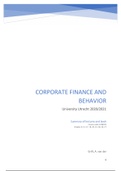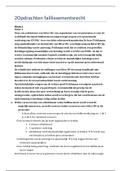Samenvatting
University Utrecht_Corporate Finance_Summary lectures_book chapter 8, 13, 17, 18, 20, 21, 28, 30, 27
- Instelling
- Universiteit Utrecht (UU)
Extensive summary corporate finance and behavior from all chapters and lectures. All formula's and topics are discussed extensively (kind of like a for dummies version). Please check out my extended formula sheet as well. In here is an overview of all formula's again very extensive.
[Meer zien]






